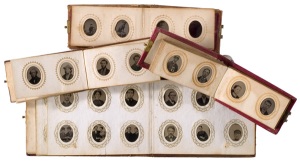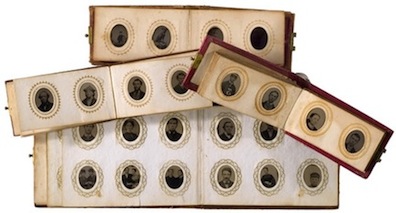For this thread read, read Chapters 12 and 13 in the texbook (free pdf version here or purchase hard copy here).
There are all the details of cases, dating and all that, but these different photos are not at all hard to identify.
Daguerreotype = on a mirror-surface. It really is like the image is on a mirror, and the image appears and disappears as you change the angle.
Tintypes = on dull, usually brownish metal. Tintypes area attracted to a magnet, while Daguerreotypes are not.
Ambrotype = on glass, usually clear glass (sometimes but not often tinted rose colored). The back sometimes has black lacquer on it.
Opalotype (scarce) = on milky white glass. Has an obvious white appearance, though can sometimes be hand tinted or colored.
Ivorytype (rare!) is on ivory or faux ivory. Usually hand painted to resemble a little painting.
Orotone = backed in genuine gold, so will have golden appearance and the back will be covered in gold.
Autochrome = early color photo on a pane of glass.
Glass negatives and slides. Glass for slides and negatives was replaced by plastic film in the 1930s, so if you see a photo on glass you can be confident it’s antique. Glass = old.
If you take the photo out of its case or frame, you will have no trouble identifying it. Sometimes if it has the original paper seal on back, people prefer to leave it as is. However, if you remove the photo from its case or frame, you can put it back together with no trouble
* * * *
 Tintype albums. The tintypes were slipped into albums pages with openings for the images to be viewed. You can easily remove the tintypes, as they are not glued in. The albums are leather bound and have latches.
Tintype albums. The tintypes were slipped into albums pages with openings for the images to be viewed. You can easily remove the tintypes, as they are not glued in. The albums are leather bound and have latches.
Gem tintype albums mean they have gem tintypes– or tintypes that are stamp sized. You can find these for sale on ebay elsewhere. Gem tintypes were either slipped into albums such as these or into CDV-style holders. The tintype CDVs looks just like regular CDVS, except the have tintypes. The backs will have the standard photography studio info.
You can also find albums that hold tintype CDVs. They pages were often designed so both the front and back of the CDV is shown through openings– so you can see the studio info on the backs by flipping the pages.
* * * *
Here are some youtube videos showing the different types of photos:
The following are links to further reading:
* * * *
Homework questions for Assignment #4
13) What materials are daguerreotypes, tintypes and ambrotypes made out of?
14) According to the chart in the chapter 12, what size is a 1/4th plate Daguerreotype?
15) How do you tell the difference between a tintype and a daguerreotype?
16) What was the first true color photograph and what material was it made out of?
17) Briefly describe what an opalotyle looks like and is made out of?
18) What are the differences between an ivorytype and an orotone?
19) Pre-1910 negatives and slides are made out of what material?
* * * *
Course Assignments:
